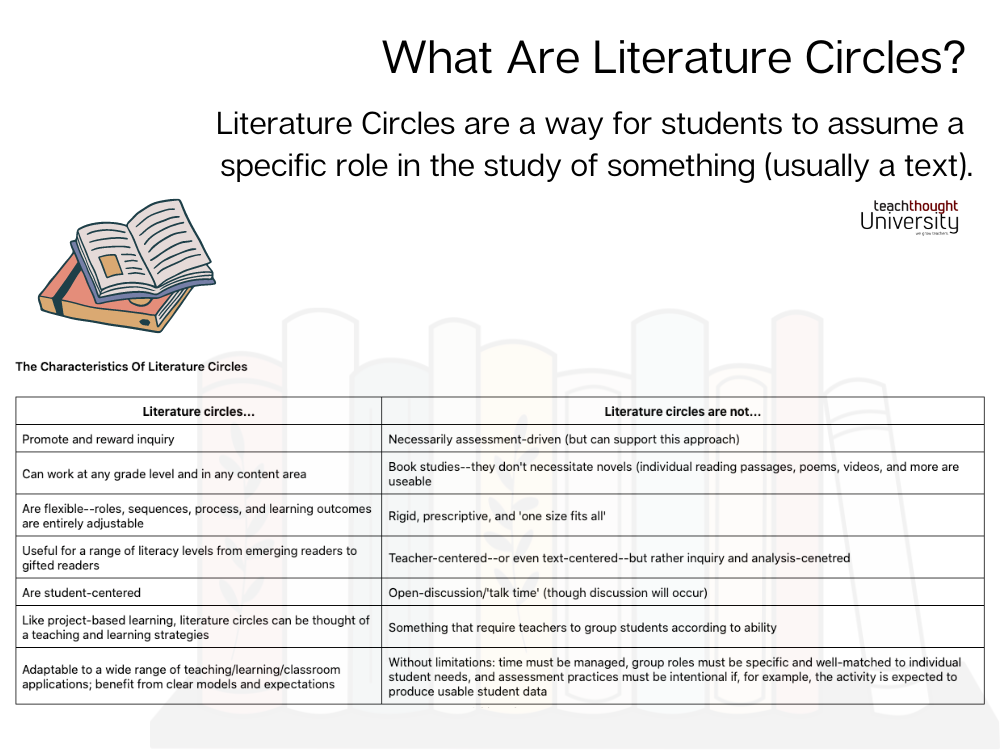
What Is A Literature Circle?
by Terry Heick
Literature Circles are a way for students to assume a specific role in the study of something (usually a text).
Though almost always associated with the content area of ‘Literature’ or ‘Language Arts’ in North America, the concept of studying a topic in groups by assigning functional roles for each group member can be applied in the study of almost anything (something I will cover in an upcoming post on how to teach with Literature Circles).
For now, let’s review the key components of this versatile teaching, learning, and literacy strategy.
See also Reading Response Questions That Work With Almost Any Text
The Characteristics Of Literature Circles
| Literature circles… | Literature circles are not… |
|---|---|
| Promote and reward inquiry | Necessarily assessment-driven (but can support this approach) |
| Can work at any grade level and in any content area | Book studies–they don’t necessitate novels (individual reading passages, poems, videos, and more are useable |
| Are flexible–roles, sequences, process, and learning outcomes are entirely adjustable | Rigid, prescriptive, and ‘one size fits all’ |
| Useful for a range of literacy levels from emerging readers to gifted readers | Teacher-centered–or even text-centered–but rather inquiry and analysis-centered |
| Are student-centered | Open-discussion/’talk time’ (though discussion will occur) |
| Like project-based learning, literature circles can be thought of a teaching and learning strategies | Something that require teachers to group students according to ability |
| Adaptable to a wide range of teaching/learning/classroom applications; benefit from clear models and expectations | Without limitations: time must be managed, group roles must be specific and well-matched to individual student needs, and assessment practices must be intentional if, for example, the activity is expected to produce usable student data |
What Are The Roles In Literature Circles?
While there aren’t exact roles that have to be used in every application of Literature Circles, there are some common trends. Students are usually grouped in small groups of 4-6 students, with a range of student roles including:
Artist/Graphic Designer/Illustrator: Respond to, capture, or document text analysis using visual imagery, drawings, etc.
Connector: Make connections–text-to-self, text-to-text, or text-to-world, for example. Connections within a text can also be made.
Discussion Leader: Lead discussion of the text within the group circle, or between groups.
Fact-Checker: Verify claims in non-fiction text
Note-taker: Document important ideas, themes, etc., from the text for future reference
Passage Picker: Select critical passages from fiction or non-fiction text for closer reading, sharing, etc.
Researcher: Similar to a fact-checker but also useful for analyzing fiction and poetry–researching to understand an author’s background, contextualizing settings or themes, etc.
See also What Are The Five Steps Of The Writing Process?
Spokesperson: Make formal or informal statements on behalf of a group–in a presentation, for example.
Summarizer: Distill a non-fiction text into main points; distill fiction into a brief, cohesive narrative that captures critical themes
Time Manager: Make sure the literature circle stays on pace to complete necessary work within a given time frame
Vocab Technician/Word-Finder: Scrutinize the diction of a text
Literature Circle Sample Prompts
In Critical Reading: 50 Sentence Stems To Help Students Talk About What They Read, I offered examples of specific ways students might begin to respond to a text. Examples include:
‘I noticed…’
‘I loved…’
‘I was confused by…’
‘I noticed that/how…’
‘_____ helped me infer that _____’
‘I can tell that _____ because _____’
‘This reminds me of _____’
Benefits Of Literature Circles
Flexible, usable in a wide range of classroom applications from kindergarten to university-level work
Roles can be rotated so that students are allowed to experience an individual text analysis from multiple perspectives
Accessible voices for hesitant students: by being placed in groups, students learn through ongoing discussion with one another in a setting small enough that everyone is able to find a voice (and for many, unable to remain anonymous in the larger setting of whole class discussions)
Increased transparency: students are required to perform specific tasks with specific outcomes
Applicable to a range of content areas
See also What I Tell Students When They Say They Don’t Like Reading
Drawbacks and Criticisms of Literature Circles
Can emphasize social interactions
It can be easy to ‘waste time’–or for the process to feel rushed in order to avoid ‘wasting time’
Advantageous for socially comfortable students
Inherently limit students’ method of interacting with a text
Not always natural for student data to emerge from the process
